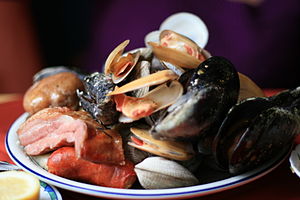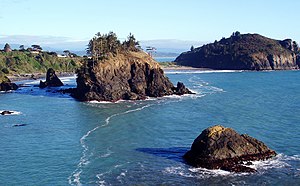Ilfenóra
| Ilfenóra | |
 Flag | |
| Country | |
| Theme | |
| Capital | Élastinen |
| Largest City | Íarþasar |
| Population | 15 million |
| Chief Executive | Saverius H.T.M. Panetón |
| Chancellor | Diarmuid Ó Séaghdha |
| Legislature | Auditorium |
| Stanora seats | 3 |
| Official language | West Coast Marine Coscivian Serradan Coscivian Kiravic Coscivian |
| Postal Abbreviation | ILF |
Ilfenóra is a state of the Kiravian Federacy, located on the west coast of Great Kirav. It borders Cascada to the north, Metrea to the south, and the Pelagic Ocean to the west. Together with its northern and southern neighbours, it belongs to the historical and cultural region of Farravonia that spans most of the western coast
Geography
Ilfenóra's defining geographic features are the Coast Ranges and the Emynlúana Mountains, both of which span the full length of the west coast. The high Emynlúana Mountains form the natural eastern boundary of the state and the western boundary of the Western Highlands. The lower-lying Coast Ranges, fed by the moisture rolling off the Pelagic Ocean, are covered in thick temperate rainforest. The mountains themselves touch the sea directly in several places, but for most of their length in Ilfenóra, they are separated from the water by a narrow coastal plain, where cities such as Íarthasar, Nevisar, and Inna are situated. There are several offshore islands belonging to the state, all of which are geological extensions of the Coast Ranges. The largest of these is Xoésa.
Between the Coast Ranges and the Emynlúana Mountains is a broad central valley that is home to a majority of Iflenóra's population and most of its agricultural and industrial activity.
Ilfenóra has a temperate oceanic to hyperoceanic climate characterised by a cool, oceanically moderated temperature range and heavy precipitation year-round. It is traversed by the hemiboreal and supratemperate thermal belts.
Politics & Governance

Ilfenóra is a semi-presidential republic within the Kiravian Federacy. Executive power is shared between a Chancellor, who is elected by the legislature and (usually) from among its own membership, and a Chief Executive or Governor who is directly elected by the people. The state Cabinet is appointed by the Governor but is thereafter dually accountable to the Chancellor and the Governor, both of whom may dismiss its members.
There are fifteen registered parties that qualify for statewide ballot access in Ilfenóra. Of these, the Independent Republican Union (conservative), Christian Democratic Party (Christian democratic, centrist), ________ Party (social liberal), Union of Democrats and Independents (market liberal, centrist), ________ Party (progressive-populist), Social Christian Party (Christian left), New Horizon Party (reformist), _______ _______ ______ (ordoliberal, agrarian), Convist Party (kirosocialist), and Ecological Republican Party (environmentalist) have the most consistent and significant representation; with the IRU, CDP, and _ _ _ usually controlling the Chancellorship and forming the core of cabinet coalitions.
In federal politics, the Ilfenóra generally makes a strong showing for the Federalist Republican Alliance, giving all three of its Stanora seats to SRA affiliates in every election from the fall of Kirosocialism until the latest 2120X election, when the Caritist Social Union captured one seat. As in the other weast coastal states, the Ilfenóran public and political class have a very favourable attitude towards Crona and Pan-Cronan institutions, but the Kiro-Hekuvian Party's advertisement and electoral campaigns in the state have garnered some support for a more independent and more definitively pro-Hekuvian foreign policy.
Local Governance
Ilfenóra has both strong countyships and strong municipalities. This is a product of the state's human geography, which includes dense, populous urban centres demanding dedicated governmental attention, and larger areas comprising smaller settlements and dispersed farmsteads and forest hamlets that depend on countywide agencies and their resources for proper governance and public services.
Ilfenóran municipalities are reasonably free to annex adjacent unincorporated areas, subject to the consent of landowners and certain legal conditions. However, municipalities with populations of over 25,000 are allowed (and, when directed by the state government, required) to establish and serve coscivianwordheres or "suburban service halos" extending a certain radius from their boundaries, to which they are responsible for providing police, sanitation, education, utility, and other services. Municipalities can collect service fees and relevant taxes from the halos to cover the costs of these services, but cannot legislate for them.
Law
Ilfenóra is a fusional marriage state.
Ilfenóra has a seatbelt law that is not actively enforced. It requires vehicle registration plates on the aft end of four-wheeled motor vehicles only.
Society & Culture


The most populated areas of Ilfenóra belong to the West Coast cultural region of Great Kirav. In common with the rest of the region, Ilfenóran culture has strong creative, innovative tendencies that are most evident in the coastal cities. These areas are known for their modern architectural styles, experimental and syncretic approaches to food, art, and design, and more optimistic attitude towards change and development compared to the Kiravian mainstream.
The cities, towns, and rural areas of the Contracoastal Valley to the east of the Coast Ranges constitute the central portion of the West Coast "Rosary Belt" stretching from Venèra to southern Metrea. Religious adherence in this region is overwhelmingly Roman Catholic, and Catholicism is extremely influential in local culture and daily life. The Ilfenóran stretch of the Rosary Belt is home to several Catholic universities and seminaries, as well as important religious shrines such as that of St. Imanūen of Þyferra. Though isolated from the region geographically, the offshore island of Xoésa is widely considered to be an extension of the Rosary Belt due to similar social and religious characteristics.
Describe strong Urom contribution to the state's cuisine, material culture, immaterial culture, and genetics here. Also mestiço/Æran/Iyrlan potato island off the coast.
40.6% of Ilfenórans are Coscivians of unmixed ancestry, and 36.3% are Coscivians of mixed Éorsan and Urom ancestry. 18.1% are Urom (some of which have matrilineal Coscivian ancestry), and the remaining 5% are divided among Celts, Tryhstians, Sinyolans, Cronans, Hekuvians, and Finns.
The largest Coscivian ethnosocial group in Ilfenóra are the Serradans, concentrated in the Contracoastal Valley. The Serradans, most of whom have a significant degree of Urom admixture, trace their ethnogenesis to the Jesuit-driven Christianisation and colonisation of the Contracoastal Valley, and their culture forms the foundation of the regional culture of the Rosary Belt. Western Highlanders are the dominant group in the Emynlúana mountain vales. The coastal cities are ethnically diverse, with the largest Coscivian groups being Pelargians, Lusans, Ærans, Kostiatans, Insdans, Kaskans, Engrìm, Korskans, Lúnstans, Umcarans, and Æonaran Coscivians, Margarittans, and Illotem. Inna has large communities of Hisrovans, Krinstans, Thasyrans, and Ig̊órans.
Ilfenóra has fewer foreign expatriates and non-Coscivian immigrants than its northern and southern neighbours, but trade and investment opportunities and the draw of the state's religious and educational institutions have nurtured enduring, if somewhat transient populations of Arcers, Hekuvians, Paulastrans, and Levantines. Íarþasar has a Daxiatown surrounding a stretch of 16th Street recently renamed Todd Row in honour of noted Daxian diplomat and champion of national sovereignty Mibb Todd.
Economy
Ilfenóra is has the fastest-growing economy of the west coastal states, benefitting from abundant natural resources, increased availability of capital, and business links to Crona and Caphiria. Though historically less developed than adjacent Cascada and Metrea, and more reliant on extractive industries while its neighbours rapidly transitioned towards economies based on high-tech industry and services, Ilfenóra has nonetheless shared in their prosperity. Nevisar is the state's financial centre.
Mining has played an important role in the Ilfenóran economy since the Silver Rush, and continues to account for the majority of the state's commodity sales. Ilfenóra has large reserves of copper, silver, and titanium, as well as 76% of the Federacy's proven lithium reserves. Chromium, feldspar, rhenium, cobalt, borates, Fuller's earth, rhyolite, and beryllium are also actively extracted from Ilfenóra. Though it directly employs a small and shrinking share of the Ilfenóran workforce, the mining sector is the lifeblood for many communities in the state, particularly in the [Whatever name we came up with for the eastern mountain range].
Ilfenóra contributes 43% of the Federacy's total basalt fiber production.
A biomedical technology and healthcare sector based in Þyferra is gaining nationwide recognition, though it is still dwarfed in scale and output by its counterparts in Hanoram and Bérasar. Þyferra is home to SAK Adver-Þevesta, the biotechnology and aging-management division of the Cascada-based Lexicon Group, and also to the flagship hospital and management offices of the St. Imanüen Health Network, the second-largest system of Catholic hospitals in the Federacy.
Settlements
- Íarþasar - Ilfenóra's largest city, situated at the opening of a pass through the Coast Ranges where the Portola River empties into the sea. Íarthasar's strategic location has allowed it to become and remain an important commercial and industrial centre.
- Nív-Xavier - One of the three cities of the "Jesuit Trinity" regarded as the primary "buckles" of the Rosary Belt, the other two being Nív-Frankisar, Cascada and Nív-Enyékosar, Metrea. It is home to the nationally-renowned Catholic University of Ilfenóra, the Catholic Evangelical Linguistics Institute, the Cathedral of St. Francis Xavier, and the Kiravian national headquarters of the Jesuit Order.
- Nevisar - Ilfenóra's financial centre, home to most of its banks and investment firms, as well as many companies involved in capital-intensive industries. Since 21199, it has been the headquarters of the Kiravian Navy's Western Fleet.
- Inna - Coastal city known for its musical output, Southeast Éorsan cultural heritage, and nightlife. Neśtoya State Beach, one of very few true beaches in Ilfenóra and a popular recreation area, is located six kilometers north of the city.
- Þyferra - An inland city known for its strong biomedical sector and its botanical gardens.
- Serrasar - An important city of the Rosary Belt.
- Ūniveron - Touting itself as "where the Rosary Belt meets the Tech Corridor", Ūniveron is located longitudinally halfway between Nevisar and Serrasar, combining financial capital from the former with human capital from the Rosary Belt's may colleges and universities to become a growing hub for high-tech and knowledge-intensive services.
Imáxes da Ilfenhóra
Notable Ilfenórans
- Adheritus Ilkaśvar - Prime Executive of the Kiravian Federacy, native of Xoésa Island.
- Irasur Valyrian - Hekuvian politician, born and raised in Nevisar.






